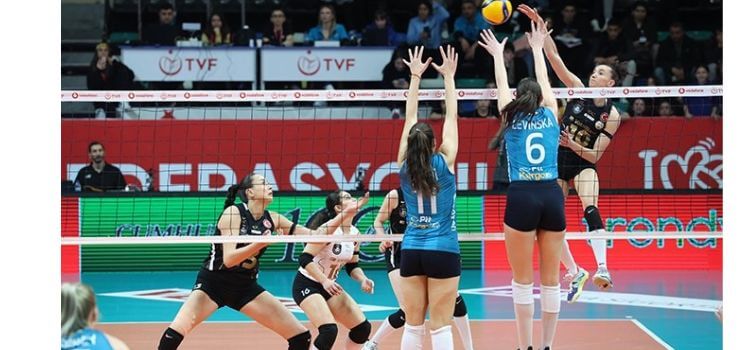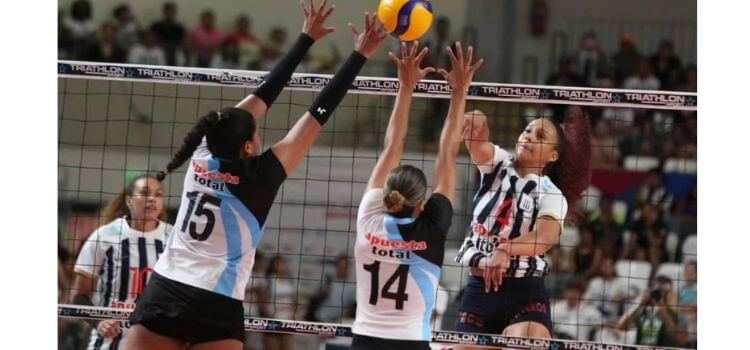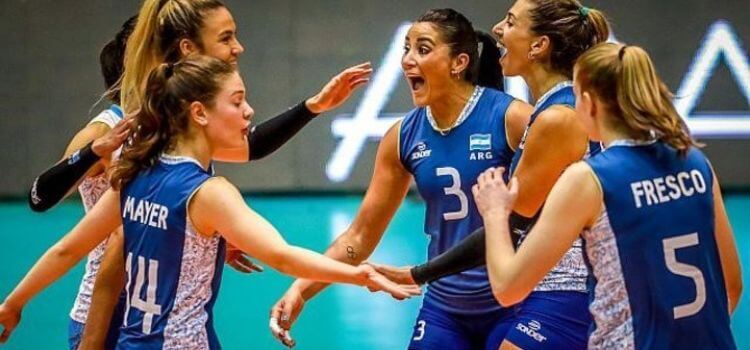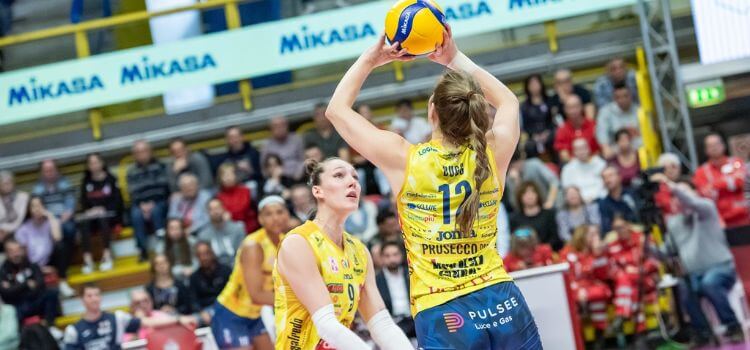As an Amazon Associate, I earn from qualifying purchases
Ever watch a volleyball game and hear the referee call a “double hit”? It can be a confusing call, especially for new players. But fear not, spikers and setters alike! This guide will break down everything you need to know about double hits in volleyball, helping you avoid this common violation and elevate your game.
What Does a Double Hit Look Like?
A double hit in volleyball can manifest in a few ways, and it’s not always a clear-cut case of two distinct touches. Here’s what to watch for:
Lets See : Best Volleyball Shoes for Liberos
Obvious Double Contact: This is the most straightforward scenario. A player hits the ball with one body part (hand, arm, etc.), and then makes another distinct contact with a different body part immediately after. Imagine a player trying to bump a ball with their forearms, but it pops up and they accidentally slap it with their hand to control it further. That’s a double hit.
Single Body Part, Double Touch: This can be a bit trickier. It occurs when the ball bounces off the same body part twice in a row. This might happen during a dig attempt where the ball deflects off a player’s forearm and then pops back up before they can fully control it.
Lets See: The Best Beach Volleyball Bikini Bottoms
Trapping: Holding the ball between your arms for too long is also considered a double hit. This usually happens unintentionally during a setting attempt where the player loses control and the ball gets caught between their forearms.
Beyond the Basics:
Intent Doesn’t Matter: Even if a player accidentally double hits, it’s still a violation. Referees are looking for the actual contact, not the player’s intention.
Speed of Play: As skill level increases, the game gets faster. Double hits can become harder to spot, especially when players are reacting instinctively to powerful attacks. Referees will look for signs of unusual ball movement or hesitation in a player’s actions to determine a double hit.
Remember, if you’re unsure whether you double hit the ball, it’s always best to let a teammate handle the next touch to avoid a violation.
What About When Two Players Hit Simultaneously?
In the fast-paced world of volleyball, situations arise where two players might brush the ball at nearly the same time. Here’s how the rules handle this scenario:
Simultaneous Contact – Not a Double Hit: The good news is that a near-simultaneous touch by two players (usually teammates) isn’t automatically considered a double hit. As long as both players are “out” for the next touch, it’s considered a legal play. This allows for slight adjustments and teamwork during digs or receptions.
Let See 10 Best Asics Youth Volleyball Shoes: Reviewed
Double Play After Simultaneous Contact: However, things change if either player attempts to hit the ball again immediately after the simultaneous contact. This would be a true double hit violation. Imagine two players bumping a strong serve simultaneously.
If one player bumps the ball again right away for a set, it’s a violation. They both need to be “out” of the play before another teammate can handle the ball.
Referee’s Call: Determining the exact timing of a simultaneous touch can be tricky. Ultimately, the referee has the final say in whether it’s a legal play or a double hit. If there’s any doubt about both players being “out,” the referee might call a double hit to maintain the flow of the game.
Lets See : Best Used Volleyball Training Equipment
Key Takeaway:
Simultaneous contact itself isn’t a double hit. But remember, both players involved need to be “out” before the next touch to avoid a violation.
Double Hits Off the Serve
The serve is a unique situation when it comes to double hits in volleyball. Here’s why:
First Touch Exception: One of the key rules to remember is that the serve is the first touch for the serving team. This means a player is allowed some leeway with their hand contact during the serving motion.
Continuous Movement: Unlike other situations in volleyball, a player can technically contact the ball multiple times during the serving motion as long as those contacts are part of a continuous movement. This allows for a smooth serving action where the player might adjust their hand position slightly before striking the ball.
Double Hit Violation: However, the key here is continuity. If the serving motion stops or hesitates at any point before hitting the ball, that’s considered a double hit violation. Imagine a player raising their hand to serve, then pausing and making a second distinct contact with the ball before serving – that’s a double hit.
Tips for Avoiding Double Hits While Serving:
Develop a fluid serving motion: Practice a smooth, continuous serving action where your hand contacts the ball once as part of a flowing movement.
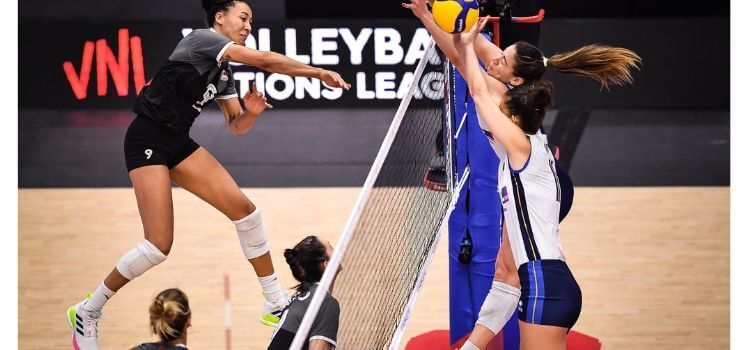
Focus on a clean strike: Aim for a single, controlled contact with the fingers or palm to propel the ball over the net.
Maintain momentum: Keep your serving motion going even if you need to adjust your hand position slightly before contact.
Lets See : Volleyball Training Equipment for Hitters: Review
By following these tips, you can ensure a legal and effective serve while avoiding the dreaded double hit call.
Execute a unified, swift overhead pass to sidestep double contacts.
The overhead pass, also known as a bump pass, is a fundamental skill in volleyball, but it’s also one where double hits can occur. Here are some key strategies to ensure clean, controlled passes and avoid double hits:
Hand and Wrist Technique:
Firm Platform: Maintain a stiff platform with your hands and wrists. Imagine your hands forming a flat surface like a small table. This rigidity helps prevent the ball from bouncing off and causing a double hit.
Focus on Fingertips: Aim for a clean, controlled contact with your fingertips. This allows for a more precise touch and minimizes the risk of the ball getting trapped between your palms or forearms.
Body Mechanics:
Controlled Movement: Avoid excessive arm or shoulder movement during the pass. This can lead to jerky motions and make it harder to control the ball, increasing the chance of a double hit.
Body Square: Stand with your body square to the direction of the incoming ball. This provides a stable base and allows you to react more effectively when contacting the ball.
Follow-Through:
Guiding Touch: Extend your hands slightly after contact to guide the ball in the desired direction. This short, controlled follow-through helps maintain control and prevents the ball from popping back up and causing a double.
Additional Tips:
Practice Visual Cues: Train yourself to focus on the incoming ball and visualize a clean touch with your fingertips. This mental preparation can improve hand-eye coordination and lead to more controlled passes.
Start Slow: When practicing overhead passes, begin with slower-moving balls. As you gain confidence and control, gradually increase the speed and power of the incoming passes.
By mastering these techniques and practicing with focus, you’ll be well on your way to becoming a master of the overhead pass, leaving double hits in the dust.
Why Do Setters Get Called For Double Hits?
Setters are the quarterbacks of the volleyball court, orchestrating the offense with precise sets. However, they’re also particularly prone to double hit calls. Here’s why:
Delicate Touch: Setting requires a delicate touch to control the ball and provide a perfect platform for the hitter. This delicate balance can be easily disrupted, leading to unintended double contacts.
Ball Control Issues: If the ball slips through the fingers or bounces off the setter’s hands unexpectedly, it can result in a double hit. This might happen due to a bad pass, a setter being set off balance, or simply a lack of practice in controlling the ball perfectly.
Lets See Volleyball Training Equipment for Home: Reviews Top Picks and Buying Guide
Setting a Powerful Hit: While a double hit is illegal when setting a standard attack, players are allowed a bit more leeway with powerful spikes. However, there’s a fine line. If a setter attempts to control a hard-driven pass and ends up making a double contact that significantly affects the ball control or trajectory of the set, it can be called a double hit.
There are some ways setters can minimize double hits:
Develop Soft Hands: Focus on developing soft, “cushiony” hands that can absorb the impact of the ball and provide a controlled touch.
Practice with Different Ball Speeds: Train with a variety of pass speeds and techniques to improve control and reaction time.
Maintain Proper Form: Upholding good setting form with proper hand and body positioning allows for better control and reduces the risk of double contacts.
Visualize the Set: Mentally picture the desired trajectory and height of the set before contacting the ball. This visualization can improve focus and lead to a more controlled touch.
By refining their technique and focusing on ball control, setters can significantly reduce the chances of double hit calls and become even more effective offensive players.
What is a Hard-Driven Ball in Volleyball?
In volleyball, a hard-driven ball refers to a powerful attack hit or spike executed with significant velocity. Imagine a player jumping high and hammering the ball towards the opponent’s court with great force. That’s a hard-driven ball.
Let See: 10 Best Seats for Volleyball Game
Here’s why the concept of a hard-driven ball is important:
Relaxed Rules for Defensive Contact: While a double hit is usually a violation, there’s a slight exception for hard-driven balls. Since the speed and power of the attack make it difficult to react with perfect control, defensive players are allowed a bit more leeway with their hand contact.
Momentary Control: When faced with a hard-driven ball, players on defense (diggers, blockers) can use a momentary “lift” with open hands or forearms to control the ball for a single defensive touch. This allows them to react more effectively and potentially deflect the powerful attack.
Referee’s Discretion: It’s important to note that the “hard-driven” rule is subjective. Referees will use their judgment to determine if the ball’s speed justifies a slight relaxation of the double hit rule. Factors like the attacker’s approach, the trajectory of the hit, and the defender’s reaction time are all considered.
Key Points to Remember:
A hard-driven ball doesn’t excuse a full-blown double hit. The “momentary control” should be a single, instinctive reaction, not a prolonged attempt to control the ball.
This rule applies primarily to the first defensive touch. Subsequent touches by teammates still need to follow the regular “no double hit” rule.
The hard-driven ball rule doesn’t apply to setting. If a setter attempts to control a powerful hit with a double contact that significantly affects the set, it will be called a double.
Understanding the concept of a hard-driven ball will help both offensive and defensive players navigate the complexities of powerful attacks in volleyball.
What is a “Double Double” in Volleyball?
The term “double-double” in volleyball can be quite confusing because it has absolutely nothing to do with a double hit. It’s a completely different concept used for scoring and individual player performance. Here’s the breakdown:
Individual Player Stat: A double-double refers to a player achieving double-digit totals in two different statistical categories during a single match.
Statistical Categories: These categories typically include points (kills, aces, blocks), digs, and assists. So, for example, if a player scores 12 kills and digs 10 balls in a match, that’s a double-double.
Highlighting Versatility: Earning a double-double showcases a player’s versatility on the court. It indicates they can contribute offensively (kills, aces, blocks) and defensively (digs) throughout the game.
Important Distinction:
Remember, “double-double” has nothing to do with the actual act of hitting the ball twice. It solely focuses on a player’s statistical performance in multiple categories.
Conclusion
Mastering ball control is a crucial aspect of volleyball, and avoiding double hits is a key component of that mastery. By understanding the different scenarios that can lead to a double hit, you can refine your technique and become a smoother, more strategic player. Remember, practice with focus, develop soft hands for setting, and always prioritize clean touches – these are the keys to minimizing double hits and elevating your volleyball game.
FAQ – What is a Double Hit in Volleyball?
Q: What exactly is a double hit in volleyball?
A: A double hit occurs when a player makes two consecutive contacts with the ball. This can happen in various ways, including two distinct touches with different body parts, the ball bouncing off the same body part twice, or holding the ball between your arms for too long.
Q: Can two players hit the ball at the same time?
A: Yes, a near-simultaneous touch by two teammates (usually during a dig or reception) isn’t a double hit as long as both players are “out” for the next touch. However, if either player attempts to hit the ball again immediately, it’s a double hit violation.
Q: Does the serving motion count as a double hit?
A: The serve is a unique case. Since it’s the first touch, a player can technically contact the ball multiple times during the serving motion as long as the contacts are part of a continuous movement. However, any hesitation or stopping of the motion before hitting the ball will be considered a double hit.
Q: Why do setters get called for double hits so often?
A: Setting requires a delicate touch, and even slight slips or unexpected bounces of the ball can lead to unintended double contacts. Additionally, while allowed for other defensive plays, attempting to control a powerful spike with a double contact that significantly affects the set will be called a violation.
Q: What’s the difference between a double hit and a “double-double” in volleyball?
A double hit is a violation related to a player’s contact with the ball. On the other hand, a “double-double” is a completely separate term used for scoring and refers to a player achieving double digits in two different statistical categories (e.g., kills and digs) within a single match.
What is the best volleyball ball for professional players
1.Mikasa V200W Volleyball : Check Price
2.Molten FLISTATEC Volleyball :Check Price
3.MIKASA V300W Volleyball : Check Price
5.Wilson AVP Official Beach Volleyball: Check Price
6.Tachikara SV5WSC Volleyball: Check Price
7.Runleaps Volleyball, Waterproof Indoor Outdoor Volleyball: Check Price
8.Senston Volleyball Official Size 5 – Waterproof Indoor/Outdoor: Check Price
9.Tachikara Institutional Quality Composite Leather Volleyball,: Check price
